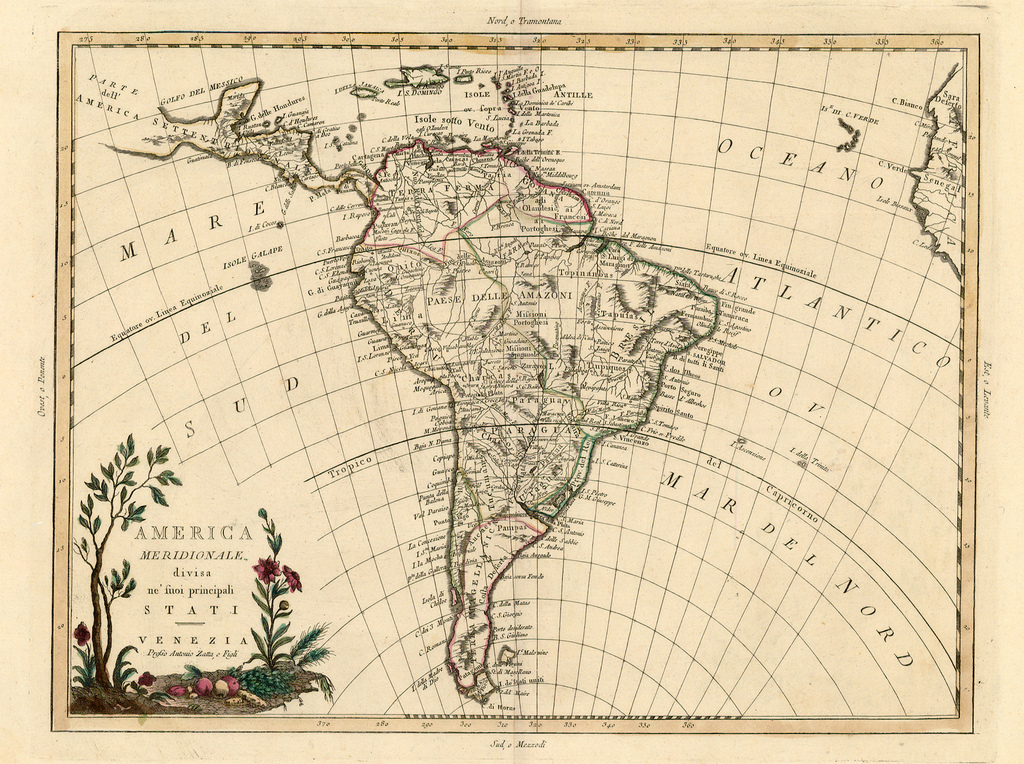{{currentView.title}}
October 01, 2009
Theater of Jihad: Latin America
 Map of South America, 1785 (Image by TheJourney1972, available at Flickr)
Map of South America, 1785 (Image by TheJourney1972, available at Flickr)Demographics: Approximations of the Muslim population in Latin American vary wildly. While some Muslim sources estimate the number of Muslims residing in the region at 6 million (out of a total populace of over 500 million), other sources put the figure in the hundreds of thousands. Though Islam is without a doubt one of the fastest growing faiths in the region—a collective result of intermarriage, conversion, and immigration—there are simply few reliable statistics. Indeed, in Brazil, for instance, the Muslim population has been cited as low as 27,000 and as high as 1.5 million. Less open to conjecture, however, is the diversity of Muslim communities in Latin America. Many of the region’s Muslims hail from Lebanon, Syria, and Palestine (though they are outnumbered considerably by Christian Arabs from the Levant), as well as Afghanistan, Pakistan, Indonesia, and India. Those who have emigrated from the latter countries have tended to settle more in the Caribbean basin, particularly Trinidad and Tobago. Almost all of the Muslims living in Latin America adhere to the Sunni denomination of Islam.
Synopsis
Since its inception, Al Qaeda and its affiliates have carried out terrorist attacks in North America, Europe, Africa, Asia, and the Middle East. Conspicuously absent from the list of locales in which it has killed and maimed innocents is Latin America, often considered the possible “last frontier of international terrorism.” Although Al Qaeda has yet to strike in the region, it has not been for a lack of interest; indeed, South and Central America would appear to offer the network an ideal staging ground given its attractive brew of lawless frontiers, anti-U.S. sentiments, expatriate Arab communities, robust narcotics industry, and homegrown rebel movements. Perhaps the greatest attraction of Al Qaeda to Latin America is the region’s geographic proximity to the United States and the prospect that its porous southern border holds for again hitting “the Great Satan” on its very own soil.
Lying at the epicenter of militant Islamist activity in Latin America is an area known as the Tri-Border Region, a veritable no-man’s land where the borders of Brazil, Paraguay, and Argentina converge and where tens of thousands of illegal Muslim immigrants live, among them many Lebanese. Surrounded by unpatrolled waterways and unregulated and hidden airfields, the area—known for its lax border security—has become the perfect hub for smuggling, document forgery, and weapons and narcotics trafficking. Radical Islamist outfits, including Hamas and Hezbollah, have been active across the region, exploiting its unregulated financial networks and free trade zones to engage in various money laundering schemes. Estimates have varied on the extent of the illicit cash funneled back by operatives to their parent organizations in the Middle East, but approximations have put the annual figure in the tens of millions. While there is also concern that Al Qaeda may seek to form an unholy union with drug cartels for similar purposes, there is little evidence to date that it has forged such alliances, though a lack of ideological kinship does not seem to be an impediment. (Nor, for that matter, do sectarian considerations appear to preclude cooperation in Latin America, although there is no proof of an Al Qaeda-Hezbollah nexus at present either.)
The Tri-Border Region is not the only area in Latin America where Al Qaeda may try to establish a foothold: Venezuela’s Margarita Island and southern Colombia’s ungoverned expanses could also provide Osama bin Laden’s global network with ample opportunities to set up shop. The U.S. Government has already detailed explicit cases of business owners on Margarita Island funneling money to Hezbollah. In southern Colombia, Arab Muslims—many of whom are of Lebanese, Palestinian, or Syrian descent and immigrated to Latin America in the 1960s and 1970s—constitute a small portion of the population, but recent immigrants to the country have tended to exhibit more religiosity than previous generations of their kinfolk.
Although the radicalization of Latin America’s Muslim community, including many new converts, may be a long-term goal of Al Qaeda—there has been a noticeable proliferation of Salafist mosques in Latin America since the early 1990s and an increasing proselytization campaign on the part of Wahhabi and Saudi-funded nongovernmental organizations like the World Assembly for Muslim Youth—the most immediate threat posed by the group is more likely to come in the form of its exploitation of Latin America’s loosely-regulated financial institutions, easy access to forged identification documents, and the drug trade to raise funds for the group’s operations. Despite Al Qaeda’s history of raising funds through the narcotics industry, no proof currently exists that Al Qaeda has entered into any marriage of convenience with movements such as FARC, the oldest insurgent group in the Western Hemisphere that currently controls large swaths of Colombian territory and survives off the narcotics industry.
To date, the strongest potential Al Qaeda link to Latin America has been Adnan G. El Shukrijumah, a Saudi pilot and known Al Qaeda operative. Though the mastermind of 9-11, Khalid Sheikh Muhammad, is believed to also have spent time in the region—he once encouraged alleged dirty bomber Jose Padilla to enter the United States by way of Puerto Rico or Mexico—concerns over an Al Qaeda presence there truly rose to the fore in June 2004, when Honduran authorities spotted Shukrijumah in Tegucigalpa and accused him of forging links to some of Central America’s most notorious and brutal criminal street gangs—gangs that also operate many of the smuggling routes between Mexico and the United States. Shukrijumah, Jose Padilla’s onetime accomplice in an Al Qaeda plot to simultaneously blow up apartment buildings in various U.S. cities, is also thought to have spent time in Panama prior to 9-11 conducting surveillance of the Panama Canal.
